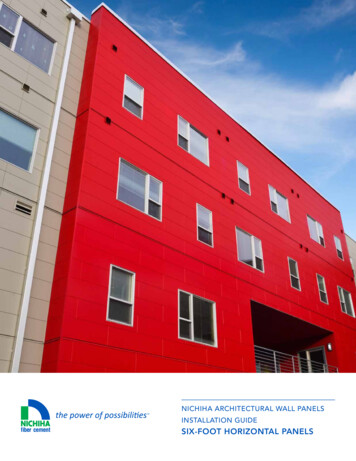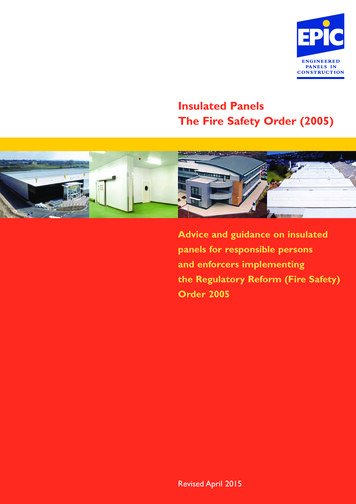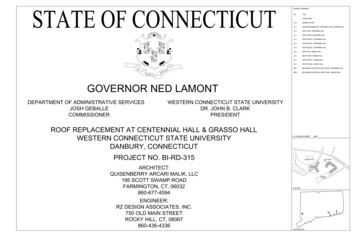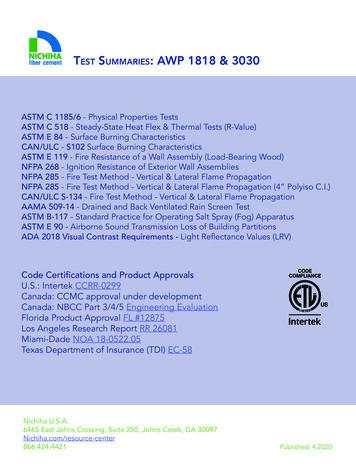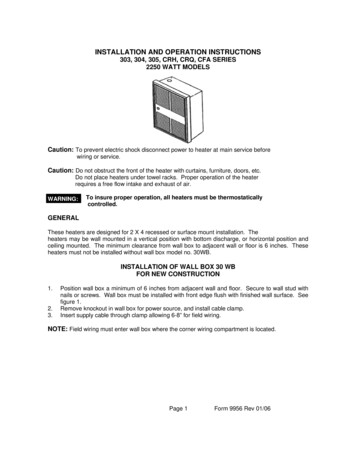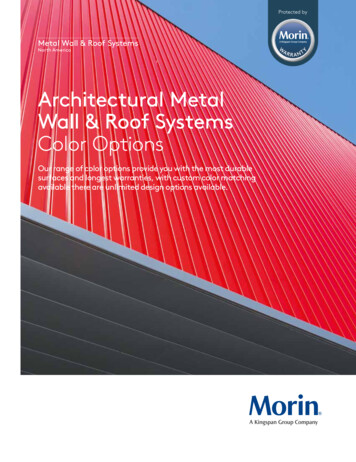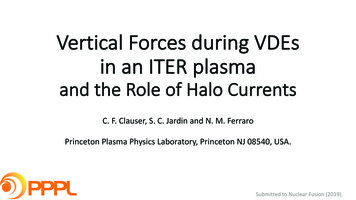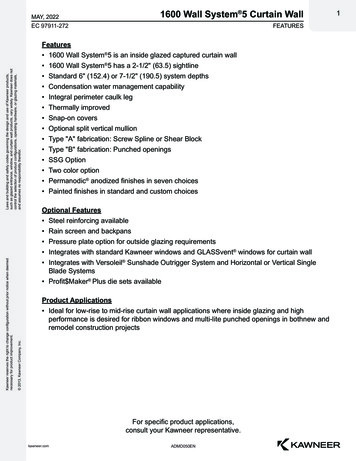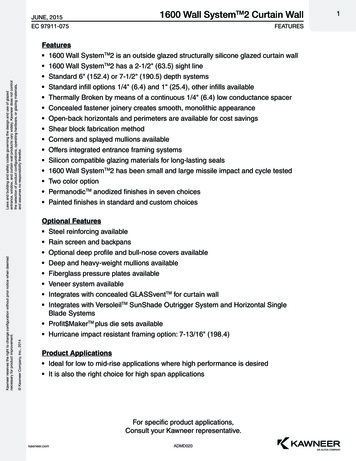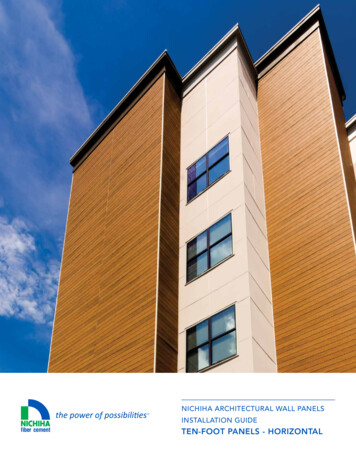
Transcription
NICHIHA ARCHITECTURAL WALL PANELSINSTALLATION GUIDETEN-FOOT PANELS - HORIZONTAL1
NICHIHA INSTALLATION GUIDE FOR TEN-FOOT PANELS - HORIZONTALNICHIHA ARCHITECTURAL WALL PANELSGENERALINSTALLATION GUIDETEN-FOOT PANELS - HORIZONTALTABLE OF CONTENTSBasicsLimitations, Technical Reviews, SpecialApplicationsSafetyFraming & SheathingContinuous InsulationWeather Resistive BarriersProduct InspectionStorage & HandlingFastenersHardware & AccessoriesPlanning & Layout344566667810Installing the Starter Track 11General Panel & Accessory BasicsPanel SelectionSealing Cut Panel EdgesCutting Ultimate ClipsFinish Clip UsageSealant Joints/Caulking121212131415Panel Installation 17Strucural Insulating Panels18Pre-Engineered Metal Buildings18Inside Corners, Windows, & DoorsInside CornersWindow SillsWindow/Door JambsWindow/Door HeadersOutside Corners191920212222Vertical Control/Expansion Joints25Horizontal/Compression Joints26Garage Doors & Other Openings27Penetrations, Railings, & Signage27Last Course 28Gable & Overhang 28Sloped Grade/Panels Below 29Cleaning Panels 30Paint Touch-Up 30Removal of Exterior Acrylic Latex Paint30Other Paint & Graffiti Removal31Repairing Minor Damage 31Panel Replacement 322This guide is intended to provide thekey information needed to successfullyinstall Nichiha’s 10-foot ArchitecturalWall Panels (AWP). Further installationinformation and technical resources suchas animated instructional videos, threepart specifications, product testing andcertifications, architectural details inAutoCAD, Revit, and PDF versions, andother technical documents are availableon our website:Nichiha.com/resources.Install products in accordance with thelatest installation guidelines and allapplicable building codes and other laws,rules, regulations and ordinances. Reviewall installation instructions and otherapplicable product documents beforeinstallation.
BASICS OF THE TEN-FOOTAWP SYSTEMNichiha 10-foot AWP dimensions are 455 mm(h) x 3,030 mm (l) x 16 mm (t). It is importantto keep in mind the actual metric dimensionswhen considering panel layout, placement ofcontrol and compression joints, and with respectto sizing window and door openings. Nominaldimensions (18 inches (h) x 10 feet (l) x 5/8 inch(t)) should only be used for conceptualization andgeneral understanding purposes.Ten-foot panel edges are ship-lapped on thetop and bottom and a factory sealant gasket isincluded on the top edge, providing a factoryseal on all horizontal joints. AWP attachmenthardware engages the top and bottom paneledges, holding the panels off the substratesurface by 10 mm ( 3/8”) and creating a closedjoint, drained/back-ventilated rainscreen systemwith concealed fastening. When accounting forthe overall thickness of the AWP system, add this10 mm plus the thickness of the panel (16 mm)for total system thickness of 26 mm.Ten-foot panels may be installed horizontally orvertically. See Installation Guide for Ten-FootPanels - Vertical.Fig. 116mm[5/8"]PANEL FRONT5"583"8455mm[18"]PANEL BACK455mm[18"]3030mm[10']455mm[18"]3"4VINTAGE WOOD PANEL DETAILSCALE: 1" 1'-0"PANEL SECTION3
NICHIHA INSTALLATION GUIDE FOR TEN-FOOT PANELS - HORIZONTALLIMITATIONS, TECHNICAL REVIEWS& SPECIAL APPLICATIONSSAFETYNatural limitations on product usage areinherent to any cladding product’s design,physical characteristics, and attachmentsystem. Nichiha AWP are intended as a lowto-mid-rise cladding product and are not foruse on high-rise buildings. Do not use AWPon open screen walls.As with any natural stone, masonry, orconcrete based product, when cutting,drilling, sawing, sanding, or abrading fibercement cladding, proper safety measuresmust be taken due to the potential forairborne silica dust, an OSHA-identifiedhazardous substance that can pose seriousmedical risks.Any project of more than three stories or45 feet, as well as those located in highwind coastal areas (Exposure CategoriesC and D with Basic Wind Speed in excessof 130 mph), requires a technical reviewby Nichiha to evaluate feasibility via ourTechnical Review and Special ApplicationForm (SAF) process. By evaluating a project’sunique criteria and design, we can referenceindependently test-derived and calculatedwind load performance data for our productsto determine whether and how the panelscan safely be installed on the project.Contact your local rep or Nichiha technicaldepartment for details or to initiate an SAF.AWP are not to be used in any applications/uses not specified or described in thisinstallation guide or other Nichiha technicaldocuments. Any such use shall not bebacked by the manufacturer’s productwarranty.4Always wear safety glasses and a NIOSH/OSHA approved respirator with a rating of N,O, or P 100. Carefully follow the respiratormanufacturer’s instructions as well asapplicable governmental safety regulationsconcerning silica. Refer to Nichiha’s MSDSfor more information.Always cut fiber cement panels outside orin a well-ventilated area. Do not cut theproducts in an enclosed area.Use a dust-reducing circular saw withdiamond-tipped or carbide-tipped fibercement saw blades.Always clean panels after cutting. Fibercement dust can potentially bind to thepanel finish.
FRAMING & SHEATHINGREQUIREMENTSPrior to Nichiha installation, closely inspectexterior wall substrate and correct anyproblems. Walls that are out of plumb,for example, can negatively impact theinstallation quality of AWP. Nichiha Spacermay be used in conjunction with panelattachment hardware if necessary to ensurean even substrate.Nichiha AWP cladding may be installed onwood or steel framing, concrete/masonrywith furring, Structural Insulating Panels (SIP),and pre-engineered metal buildings (PEMB)meeting the following requirements:WOOD STUDSSize: minimum 2x4 studsSpacing: 16” o.c maxSheathing: none, exterior grade minimum7/16” plywood/OSB (APA rated), ½” or 5/8”gypsumMETAL STUDSGauge: minimum 18 (20 gauge acceptablewith 7/16” plywood/OSB sheathing if localcode allows)Spacing: 16” o.c maxSheathing: none, exterior grade minimum7/16” plywood/OSB (APA rated), ½” or 5/8”gypsumCONCRETE/MASONRYFurring is required for installation of AWPover concrete and masonry structures.Wood Furring: pressure treated lumber 2x4or 5/4x4’s, oriented vertically, spaced 16”o.c. maxMetal Furring: hat channel, c-stud, or z-furring,minimum 18 gauge with 1-2” flanges, orientedvertically, spaced 16” o.c. max.STRUCTURAL INSULATING PANELS (SIP)SIPs should be installed in accordance withmanufacturer’s instructions and local buildingcodes. Additional special Nichiha installationrequirements for SIPs are discussed in theFasteners and Installing the First Coursesections to follow. For buildings greater thanone story, contact Technical Department forassistance.PRE-ENGINEERED METAL BUILDINGS(PEMB)Metal buildings must be new construction.No retrofits/remodels. Metal R-panels mustbe installed reversed with ridges facing theinterior and ribs spaced no more than12” O.C.Exposure Category B AreasFully enclosed metal buildings must haveminimum 24 gauge, 50 ksi yield strengthmetal R-panels.Partially open buildings, such as those withopen bays, must have girts every 3’ withminimum 18 gauge R-panels.Building height can be no greater than30 feet.Exposure Category C AreasWainscot style installations up to three panelcourses are acceptable in Exposure CategoryC areas without additional requirements.For installations taller than 3 courses, contactNichiha technical department for assistance.Additional special Nichiha installationrequirements for PEMBs are discussed in theFasteners and Installing the First Coursesections to follow.5
NICHIHA INSTALLATION GUIDE FOR TEN-FOOT PANELS - HORIZONTALCONTINUOUS INSULATIONPRODUCT INSPECTIONWhere exterior/continuous insulation is used,AWP may be installed directly over up to1” of foam plastic insulation, depending onsheathing type. Amounts greater than oneinch require a structural solution to provideattachment points for the AWP system suchas a furring grid or third-party specializedsystem. Please contact Nichiha technicaldepartment for further assistance.Inspect all products thoroughly prior toinstallation. Do not install any product whichmay have been damaged in shipment orappears to have a damaged or irregularfinish. Should you have a question orproblem with your order, contact your localdealer or Nichiha Customer Service, toll-free,at 1.866.424.4421.WEATHER RESISTIVE BARRIERSSTORAGE AND HANDLINGA weather resistive barrier (WRB) is requiredwhen installing Nichiha panels. Use anapproved WRB as defined by the 2015 IRC.Refer to local building codes.A breathable WRB is highly recommendedwhen installing Nichiha panels for residentialapplications.Breathable WRB is required for allcommercial applications. However, fluidapplied WRB is acceptable.All openings must have appropriate flashingto prevent moisture penetration. Followmanufacturer’s guidelines and all localbuilding codes.2 Fig. 26Panels must be stored flat and kept drybefore installation. Refer to storageinformation included on product pallets.If panels are exposed to water or watervapor prior to installation, allow tocompletely dry before installing.Panels MUST be carried on edge. Do notcarry or lift panels flat. Improper handlingmay cause cracking or panel damage.Direct contact between the panels andthe ground must be avoided at all times.It is necessary to keep panels clean duringinstallation process.The custom color finish of Illumination Seriespanels requires 30 days to fully cure andextra care must be taken to avoid damage tothe paint during the installation process. Cutpanels face down. Always clean panels witha clean, soft, dry cloth after cutting as dustmay bind to finish.
FASTENERSALL APPLICATIONSFasteners must be corrosion resistant.Stainless steel or corrosion resistant coatedscrews such as hot-dipped zinc or ceramicare recommended. Comply with all localbuilding codes for fastener requirements.WOOD STUDSSTRUCTURAL INSULATING PANELS (SIP)Fasteners must penetrate stud or sill plate aminimum of 1”.One inch, full-thread, corrosion resistantwood screws must be used.Fasten starter track every 16” max.METAL STUDSScrews must penetrate stud or sill plate aminimum of 1/2”.Three threads are needed for effective grab.CONCRETE/ MASONRYFurring to Masonry: Use corrosion resistantmasonry screws or pneumatic masonry pinsand penetrate the furring strip and/or CMUthe appropriate distance in accordance withbuilding codes.AWP to Furring: Screws must penetrate woodfurring a minimum of 1” or steel by ½”.Double fastening per each Nichiha clip(minimum of 4 screws per JEL777/787 clip)is required as there are fewer or no studs tosecure the system.PRE-ENGINEERED METAL BUILDINGS(PEMB)Screws must penetrate reversed R-panel aminimum of 1/2”.Three threads are needed for effective grab.Fasteners must be spaced 12” o.c. intometal R-panel ribs.Fig. 37
NICHIHA INSTALLATION GUIDE FOR TEN-FOOT PANELS - HORIZONTALINSTALLATION HARDWARE & ACCESSORIES**ULTIMATE STARTER TRACKStarter Track serves as the foundational support for the AWP system whilealso providing faster and greater ease of installation.Horizontal Panels (10’): Starter Track FA 700ULTIMATE CLIPUltimate Clips sit on the panel shiplaps, securing AWP to the wall anddistributing dead loads to the structure. Together, Ultimate Clips andStarter Track hold the back surface of the panels off the substrate to createa 10mm (3/8”) rainscreen space.JEL 777 Clip Compatible with 16mm (5/8”) AWPJoint Tab Attachments included with the Ultimate Clip are not needed with10-foot AWP installations.FINISH CLIP (OPTIONAL)The Finish Clip provides an alternative to face fastening of AWP at certaintermination points where the panel shiplaps are removed. Install over 5mmSpacer. Refer to Finish Clip Usage section for general instructions.JE 310 Finish Clip – Compatible with all AWPCORRUGATED SPACERAt termination points where Panel Clips cannot be used, Nichiha Corrugated Spacer is required to maintain the rainscreen space and prevent paneldeflection at face fastening locations such as window sills and headers.FS 1005 Spacer – 5mmFS 1010 Spacer – 10mm8
SEALANT BACKERSNichiha Sealant Backers provide exact spacing for expansion andtermination joints and the recommended depth of sealant (75-80%).They provide faster installation than a foam backer rod and require lesssealant. At sealant joints, use a sealant that complies with ASTM C-920.Higher quality polyurathane or hybrid sealants are preferred.Single Flange Sealant Backer: FHK 1017 – 10 mmDouble Flange Sealant Backer: FH 1020 – 10 mmPANEL CORNERS (OPTIONAL)Nichiha outside panel Corners are manufactured mitered panel cornersavailable in the same finishes as all horizontally oriented AWP. Corners have3-1/2” returns (face dimension).METAL TRIM (OPTIONAL)Nichiha metal trim provides aesthetically pleasing design options forcorners, openings, and transitions, as well as vertical joints.TRIM APPLICATIONSCorner Key Outside CornersH-Mold Vertical JointsOpen Outside CornerOutside CornersBead Reveal Vertical JointsJ-Mold TerminationsL-Trim TerminationsESSENTIAL FLASHING SYSTEMAPPLICATIONSStarter* Base/Clearance ConcealmentCompression JointHorizontal/Compression JointsOverhang* Fascia-to-Soffit Transitions*Inside and outside corner segments are available.9
NICHIHA INSTALLATION GUIDE FOR TEN-FOOT PANELS - HORIZONTALPLANNING & PANEL LAYOUTHorizontal/Compression Joints: ½” (min.)horizontal, flashed break detail to allow forbuilding compression at floor lines.To ensure a successful installation, it isimportant to first plan how the panels willbe laid out, where compression and controljoints will be located, and line of sightregarding inside corners decided. Reminder:Ten-foot AWP actual dimensions are metric:455 mm (h) x 3,030 mm (l).Inside Corner Line of Sight: Sealant joints atinside corners can be placed out of view fromthe primary line of sight of a wall. Place thesealant joint on the less-viewed corner wall.Layout: Ten-foot AWP can be installed in astacked bond application.CUT PANELS: In general, it is best to avoidcutting AWP to short or narrow strips andsegments of less than 9”. Specifically, whenan individual panel is wider than a windowor other opening and is used over the heador under the sill, do not cut it to less than9” in height. (see image A)When an opening is wider than an individualpanel and two or more are needed to capover the header or cup the sill, do not cutthe panel to less than 4” in height. (image B)Vertical Control/Expansion Joints:10mm (3/8”) sealant joints that account forthermal expansion in the lateral dimension.These are often, where possible, alignedwith window or door jambs, downspouts,or other features in order to minimize theirappearance but recur every 10 feet (max) with10-foot AWP. Depending on sheathing type,additional framing, furring, or blocking maybe required at vertical joint locations.A9"B104"
TEN-FOOT HORIZONTAL PANELS:INSTALLING THE FA 700STARTER TRACKALL APPLICATIONSThe Nichiha Starter Track (FA 700) must belevel and attached at a minimum of 6” abovefinished soil grade or per local building codes(use a laser level to verify). When installingover a hard surface such as driveways orsidewalks, a 2” clearance is acceptable.Essential Starter Flashing may be installedprior to the Starter Track to conceal theclearance gap above hardscape and decking.Beginning with outside and inside cornersegments, fasten Flashing at each studlocation or every 10” o.c. to sill plate. FastenFlashing inside and outside corner segmentsto framing on both sides, keeping at least1” from vertical edges. Main segments willslide into/overlap the corner segments. AWP’sbottom face edge will extend ¾” below theStarter Track. Position Flashing and/or StarterTrack to leave 1/4” clearance between thepanel edge and Flashing.Fig. 15The Starter Track must be installed usingcorrosion resistant fasteners. Locate and markthe studs.WOOD & METAL STUDS OR FURRINGStarter Track must be secured at everystud line.CONCRETE/MASONRYWhen installing over concrete construction,the wall must be furred out with pressuretreated lumber or metal hat channel.Starter Track must be secured at eachfurring location.STRUCTURAL INSULATING PANELS (SIP)Secure Starter Track every 16” o.c. max.PRE-ENGINEERED METAL BUILDINGS(PEMB)Fasten Starter Track at every reversed R-panelrib at 12” o.c. max.Essential StarterFlashing11
NICHIHA INSTALLATION GUIDE FOR TEN-FOOT PANELS - HORIZONTALGENERAL PANEL& ACCESSORY BASICSAll trim, Single and Double Flange SealantBacker should be installed before panels.Refer to Inside Corners, Doors, & Windowsand Vertical Expansion Joints sectionsrespectively.PANEL SELECTIONNichiha 10-foot AWP are packaged with twopanels in a pack, which are placed on palletsconsisting of two stacks. Due to alternatingpatterns of texture and color betweenindividual panels as well as how the panelsare manufactured and packaged, it is best toinstall all panels from each individual stackbefore taking and installing panels from thesecond stack on the same pallet. Do notalternate installing from one stack and thesecond, which may result in undesirablepatterns.Fig. 1612SEALING CUT PANEL EDGESWhen cutting AWP, it is best to cut with thepanel face down, except when cutting brickfinish panels as it is easier to follow thesimulated mortar lines on their face.Cut and exposed panel edges mustbe primed or sealed with fiber cementsealer (e.g. DryLock ) or paint such asKilz Premium or Kilz Max . Do notuse Illumination touch up paint for edgetreatment due to the limited amountprovided. Be sure to clean panels with aclean, dry soft cloth after cutting to preventdust from bonding to the finish.
CUTTING PANEL CLIPSFig. 18JEL777 Panel Clips are 26” long. Where fulllength clips can be used, they are required.However, there may be conditions whereclips must be cut to accommodate panels orcorner pieces in smaller areas or segmentssuch as narrow columns, pilasters, or insets,recessed openings, or small areas betweenwindows.Notches on the upward panel engagementflanges indicate where clips can be cutevenly into thirds. These 1/3 segmentscan be further reduced evenly into two orfour pieces each with weep holes servingas dividing points. The smallest segmentmust include at least one downward panelengagement flange. Always use the widestclip segment possible.Cut with a non-ferrous saw blade on a bandor chop saw.Fig. 1713
NICHIHA INSTALLATION GUIDE FOR TEN-FOOT PANELS - HORIZONTALFig. 20FINISH CLIP USAGEThe Finish Clip requires added preparation ofthe panels with the use of a biscuit joiner:1. To route grooves into the top edge ofa panel, use a biscuit/plate joiner, suchas Makita’s PJ7000. A carbide blade isrecommended.2. Set the biscuit joiner’s angle guide at zerodegrees and height to ¼”.3. Set the depth of groove for a size 20biscuit to ensure the grooves are wideand deep enough for JE310 clips to seatproperly, ¼” from the back/unfinished faceof the panel.Fig. 214. Route the cut edge with the unfinishedpanel surface facing up, lining the groovesup with stud locations (16” o.c. maximum).5. The clip should fit snug but not too tightlywhen placed on the panel. Cut, routedpanel edges must be sealed with 100%acrylic latex primer or paint.Fig. 19Fig. 2214"[6 mm]12"[12 mm]PanelFront14PanelBack
SEALANT JOINTS/CAULKINGFig. 23Fasten Single Flange Sealant Backers atinside corners (one wall at corner), alongwindow and door jambs, and transitionpoints with other cladding. Fasten toframing, blocking or plywood/OSB sheathingat 12-14” o.c. with the 3/8” bump/sealantportion butting the corner or jamb.Sealant complying with ASTM C-920 isrequired where Single and/or Double FlangeSealant Backer is used.Refer to the sealant manufacturer’sinstructions or requirements.Place low-adhesive tape (masking orpainter’s) over the panel along the areasrequiring sealant joints for a clean caulk line.Fill the gap between the panels with acolor-matched/coordinating sealant whichcomplies with ASTM C-920 standard. TheNichiha Sealant Backer allows for the properdepth of sealant (75-80%).Before removing tape, press the surface ofthe sealant with a caulk spatula or similartool to ensure an even surface. Removemasking tape before sealant cures.If excess sealant adheres to panel, removecompletely using a putty knife or soft cloth.15
NICHIHA INSTALLATION GUIDE FOR TEN-FOOT PANELS - HORIZONTALTEN-FOOT PANELS - HORIZONTALINSTALLATIONAWP installation proceeds by working fromleft to right.Wood, Metal, Concrete/Masonrywith FurringFor 10-foot AWP, the left and right paneledges are flat and do not require initialcutting.The panel will fit tightly against an alreadyinstalled inside corner spacer, SealantBacker, or outside corner trim. If startingat an inside corner, predetermine whichwall will include the Single Flange SealantBacker for an inside corner detail. Considerthe location to minimize the visibility of thesealant joint line. Clad the higher visibilitywall without the sealant joint first so that theadjoining wall panels can terminate to it withthe Single Flange Sealant Backer detail.Set first panel into the Starter Track andsecure the top edge with an Ultimate Clip,placing the first clip about one inch from theleft edge of the panel. Fasten clip at eachstud location the clip reaches. Every clip willcover 2-3 studs and must be fastened toeach. (Figure 24)Proceed along the panel to the right, placinganother clip 3-4 inches from the end of thepreviously installed clip. DO NOT skip anystuds. Fasten clip at each stud location.Each 10-foot panel long edge should becovered by four clips. (Figure 25)Since 10-foot panels do not have shiplapson their short edges, a control joint, H-Mold,or Bead Reveal trim detail is needed at eachvertical joint.16Fasten the Double Flange Sealant Backerat vertical joints between panels. FastenSealant Backer on right side flange every12-14” to framing, blocking, or plywood/OSB sheathing.Install next wall panel right up to the DoubleFlange Sealant Backer and secure with clipsat each stud location. (Figure 26)Alternatively, H-Mold or Bead Revealmetal trim can be used at vertical joints forhorizontal 10-foot AWP. These trims, as wellas Nichiha Sealant Backer must be fastenedto plywood/OSB sheathing, framing, furring,or blocking. Fasten metal trim every 12-16” ina staggered fashion on alternating flanges.For H-Mold, leave a 1/8” gap between theedge of the panel and the center flange ofthe trim. Include a closed-cell foam backerrod in the trim channel to help create thisspace. (Figure 27)Verify the first course of panels is level. Largecommercial buildings require checking levelaround the entire building. (Figure 28)Complete the second and remaining nonterminal rows in the same way. Fit panelstightly together on horizontal joints, ensuringthe panel edges are properly buttedtogether. A rubber mallet or block of woodmay be used to seat the panels firmly inplace and tighten downward.The Vertical Joint Tab Attachments are notused with 10-foot AWP installed horizontally.Terminal rows such as under Horizontal/Compression Joints or at the Last Course arediscussed in subsequent sections of this guide.
Fig. 24STRUCTURAL INSULATING PANELS (SIP)In general, the steps mirror those for studwall applications. However, double fasteningper each Panel Clip (minimum of four screws,evenly spaced per clip) is required as thereare fewer or no studs to secure the system.Fig. 25There must be four clips per 10-foot paneledge.PRE-ENGINEERED METAL BUILDINGS(PEMB)Refer again to general requirementsconcerning PEMB installations in the Framingand Sheathing Requirements section.Fig. 26With R-Panels installed reversed and ribsspaced no more than 12” o.c., installAWP in the same manner as with stud wallapplications but with Panel Clips fastened toeach rib they reach. There must be four clipsper 10-foot panel long edge.Fig. 27Fig. 2817
NICHIHA INSTALLATION GUIDE FOR TEN-FOOT PANELS - HORIZONTALINSIDE CORNERS, WINDOWS,& DOORSALL APPLICATIONSAppropriate flashing should be used toprevent moisture penetration on all insidecorners, doors, and windows. Refer to localbuilding codes for best practices.Cut and exposed panel edges must beprimed or sealed with fiber cement sealer(e.g. DryLock ) or paint, such as KilzPremium or Kilz Max .INSIDE CORNERSSINGLE FLANGE SEALANT BACKER (FHK1017)Decide primary line of sight in order tominimize visibility of the sealant joint.Install the panel on the front wall (morevisible) first. Ensure panel is butted up tightto the inside corner wall. Fasten the SingleFlange Sealant Backer onto the side wallright up against the front wall panel’s edgeat 12-14” o.c.Fig. 293/8" SEALANT JOINT OVER SINGLEFLANGE SEALANT BACKERNICHIHA CLIPInstall side wall panel directly against thesealant backer and secure with Ultimate Clip.Fill space with sealant (Figures 29, 29A,B).NICHIHA PANELTRIM BOARDSFig. 29AInstall trim boards at inside corner first andbutt panel edges with a minimum ¼” gap.Single Flange Sealant Backer can also beused where panels butt to trim boards.Add ASTM C920 compliant sealant to the gap.Fig. 29B18
WINDOW SILLSFig. 30JE310 FINISH CLIPFor recessed windows, add a flashing wherethe panels will terminate so the top edge iscovered or capped at the sill.Remove the top ship-lapped edge of thepanel at the window sill, cutting the panel tothe required height, and route grooves intopanel top at appropriate width to coincidewith framing members. (Refer to Finish ClipUsage for biscuit joiner info.) Clean anydust off the panel. For windows narrowerthan a panel, only remove the portion ofthe panel edge directly under the windowbut accounting for a minimum ¼” gap atboth jambs. Cut, routed panel edges mustbe sealed with 100% acrylic latex primeror paint, such as Kilz Premium or Kilz Max.Panel edge should be spaced a minimum3/8” below a flush or overhanging windowsill to accommodate the Finish Clip.FINISH CLIPOVER 5MM SPACERFasten FS1005 Corrugated Spacer (5mm)at stud locations before setting panel intoplace.Seat Finish Clips into grooves and fasten ateach stud location, through Spacer, to securepanel into place. (Figure 30)If the top edge of the panel is fully shelteredunder the sill, it is not necessary to seal the3/8” gap. For better system performance,Nichiha recommends the vented approach.19
NICHIHA INSTALLATION GUIDE FOR TEN-FOOT PANELS - HORIZONTALFACE FASTENING(J-MOLD OPTIONAL)For recessed windows, add a flashing wherethe panels will terminate so that the topedge is covered or capped at the sill.WINDOW/DOOR JAMBSAs needed to match the window width,remove panel top ship-lapped edge, cuttingthe panel to the required height to fit belowthe window sill, leaving a ¼” gap betweenthe top of the cut panel edge and thewindow sill or trim board.SINGLE FLANGE SEALANT BACKER:Install the Single Flange Sealant Backer first,butting to the door/window jamb or trimpieces prior to installing the panels.Cut, routed panel edges must be sealed with100% acrylic latex primer or paint. Cleanany dust off the panel with a clean, soft, drycloth.Add FS1010 Corrugated Spacer (10mm) atstud locations, set the panel on the clips ofthe panel(s) below, and then face fasten top,cut edge of panel at the sill. Keep screws 1”below panel edge. This will avoid crackingor breaking the panel. Best practice is topre-drill the panel before fastening throughlow-adhesive tape applied to panel face tobe removed after patching and touch up.A minimum gap of 1/4” is required whenbutting panels into windows, doors, and trimboards.The Single Flange Sealant Backer must befastened a minimum of 12” to 14” o.c. tostuds, blocking, or structural sheathing.Cut panel to appropriate width. Remember toclean freshly cut panels with a clean, soft, drycloth.Install panels and fill gap with ASTM C-920compliant sealant.Fig. 32Single Flange Sealant BackerIf the top edge of the panel is fully shelteredunder the sill, it is not necessary to sealthe 1/4” gap. Nichiha prefers a ventedapproach.J-Mold or other trim channels can beincluded at a sill but must be placed on thepanel edge prior to face fastening panel sothat the trim is fastened simultaneously.Fig. 31J-MOLD:Pre-install J-Mold trim with a ¼” gapbetween it and the window/door jamb.Panels must fit completely within trim, withno exposed panel edges, but leaving a 1/8”space between panel edge and J-Mold.Place closed-cell foam backer rod inside thechannel to help create this gap.20Lastly, add foam backer rod and sealant tothe ¼” gap between the J-Mold and jamb.
NICHIHA CORNERS AT RECESSED JAMBS:Nichiha Corners can be used to wraprecessed window jambs. Corners havereturns of 3-1/2” (face dimension). Cut pieceas needed for shallower returns. Wrap baseof jamb with cut pieces of Starter Track (orFS1010 Spacer if face fastening)Install Corner pieces at jamb prior to mainpanels using cut Panel Clips (refer to CuttingPanel Clips section). Cut clips must retainat least one downward panel engagementflange.Install Single Flange Sealant Backer withthe sealant bump against the Cornerpiece, fastening at 12” - 14” o.c. along thefastening flange.Where Corner piece meets termination pointat window, leave minimum ¼” gap and add½” closed-cell backer rod and sealant.Refer also to Outside Corners section foralternative approach. (Figure 33)Fig. 33WINDOW/DOOR HEADERSStarter Track:When starting a course of whole panelsabove a window or door, add flashing andStarter Track at the header, installed withfasteners at each framing member.(Figure 34)Face Fastening:When adding a cut panel above theopening, install flashing and Spacer firstand then face fasten panels at each framingmember. Add tape to seal flashing to WRB.(Figure 35)Fig. 34Starter Track over flashingFig. 35NICHIHA 10MM SPACERFACE FASTENER1/4" CLEARANCE FROM EDGEOF PANEL TO FLASHING3-1/2"SINGLE FLANGESEALANT BACKER"Z" FLASHING BY OTHERSNICHIHA FACTORYCORNER OVERCUT PANEL CLI
Inside Corners, Windows, & Doors 19 Inside Corners 19 Window Sills 20 Window/Door Jambs 21 Window/Door Headers 22 Outside Corners 22 Vertical Control . the overall thickness of the AWP system, add this 10 mm plus the thickness of the panel (16 mm) for total system thickness of 26 mm.

